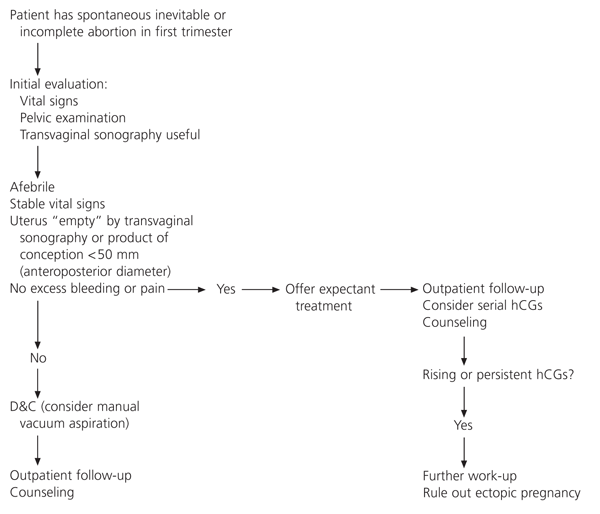
Am Fam Physician. 1999;59(11):3179-3180
Spontaneous abortion in the first trimester occurs in up to 20 percent of recognized pregnancies. However, the actual prevalence may be even higher, as many women are treated outside of a hospital setting or are unaware of the pregnancy. For the past 50 years, surgical evacuation by dilatation and curettage (D&C) has been the primary treatment of spontaneous abortion. This procedure is generally considered safe, but complications such as infection, bleeding, uterine perforation and decreased fertility occur in up to 10 percent of women. Recent studies have questioned the need for routine D&C, suggesting that expectant or medical management might be more appropriate. Geyman and colleagues performed a pooled quantitative literature evaluation to compare the outcomes of medical, surgical and expectant management of first trimester spontaneous abortions.
The literature search included MEDLINE citations on spontaneous abortion from 1966 to 1998, along with additional studies listed in the Cochrane database and in Best Evidence. Inclusion criteria consisted of all large studies that evaluated the outcomes of the three approaches to treatment of spontaneous abortion during the first 13 weeks of pregnancy. Studies that included any other type of abortion, had fewer than 15 patients and included significant medical complications or evidence of ectopic pregnancy were excluded. A meta-analysis of the data was planned but deemed impossible because of the lack of randomized controlled trials in the databases on this topic. Vaginal bleeding of less than three weeks, products of conception fully expelled by two weeks and absence of complications were considered successful outcomes of treatment.
Thirty-one studies were retrieved from the literature search. Of these, 18 met the inclusion criteria, including nine studies that evaluated expectant management, three that evaluated medical treatment with misoprostol or prostaglandin, and 10 that evaluated surgical treatment. Expectant management had an overall success rate of 92.5 percent, compared with 93.6 percent for surgical management. The number of pooled patients for these approaches was 545 and 1,408, respectively. The three studies that evaluated the outcomes of medical management included only 198 patients and had an overall success rate of 51.5 percent.
The authors conclude that expectant management of first trimester spontaneous abortion is safe and effective. Monitoring serial chorionic gonadotropin levels or examining the uterus with transvaginal sonography should be considered in select patients to rule out ectopic pregnancy. Surgical treatment is indicated if the patient has persistent brisk vaginal bleeding, infection or unacceptable pain, or if the gestational age of the fetus is greater than 13 weeks. For more information, see the accompanying figure detailing specific approaches to management of spontaneous abortion. Further studies, particularly randomized controlled trials, are needed to clarify the parameters and indications for expectant management of spontaneous abortion.
